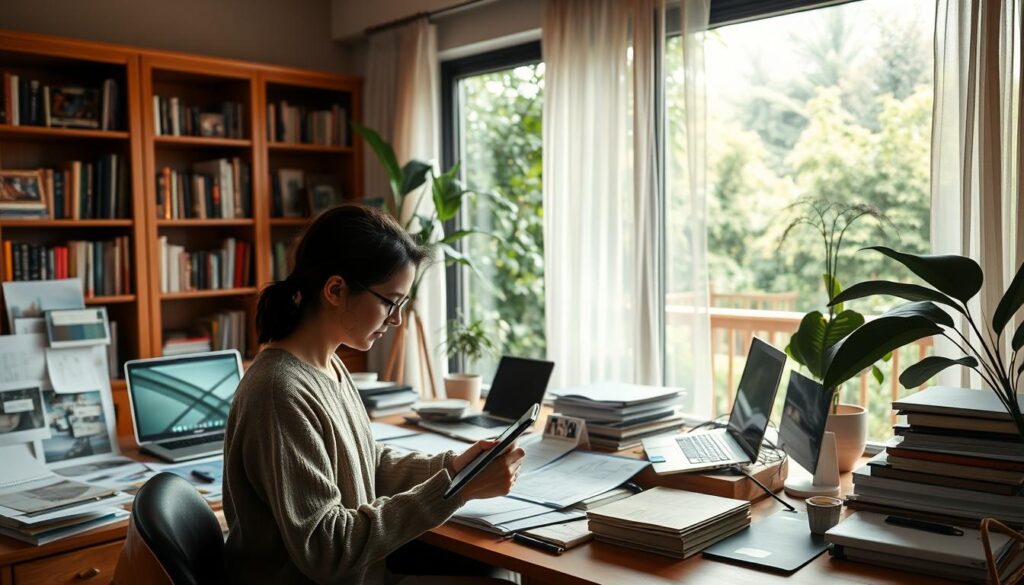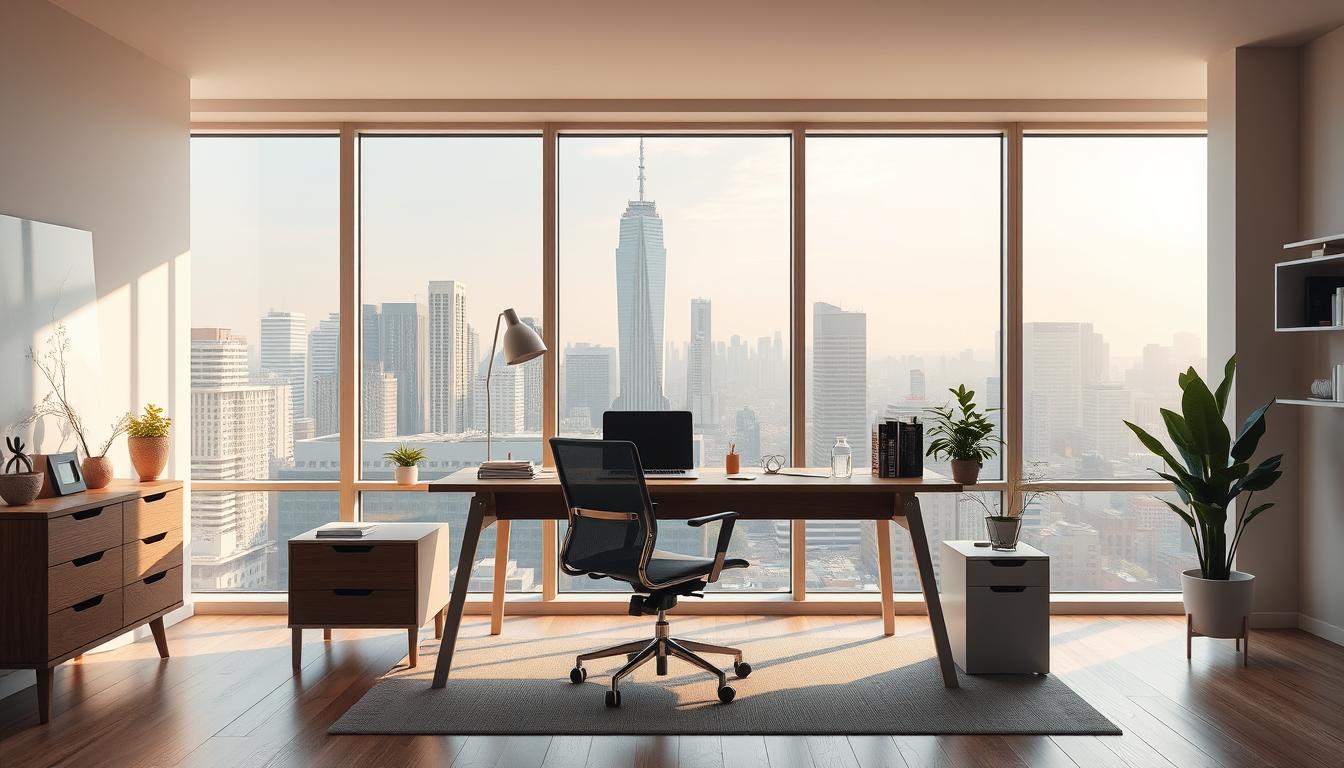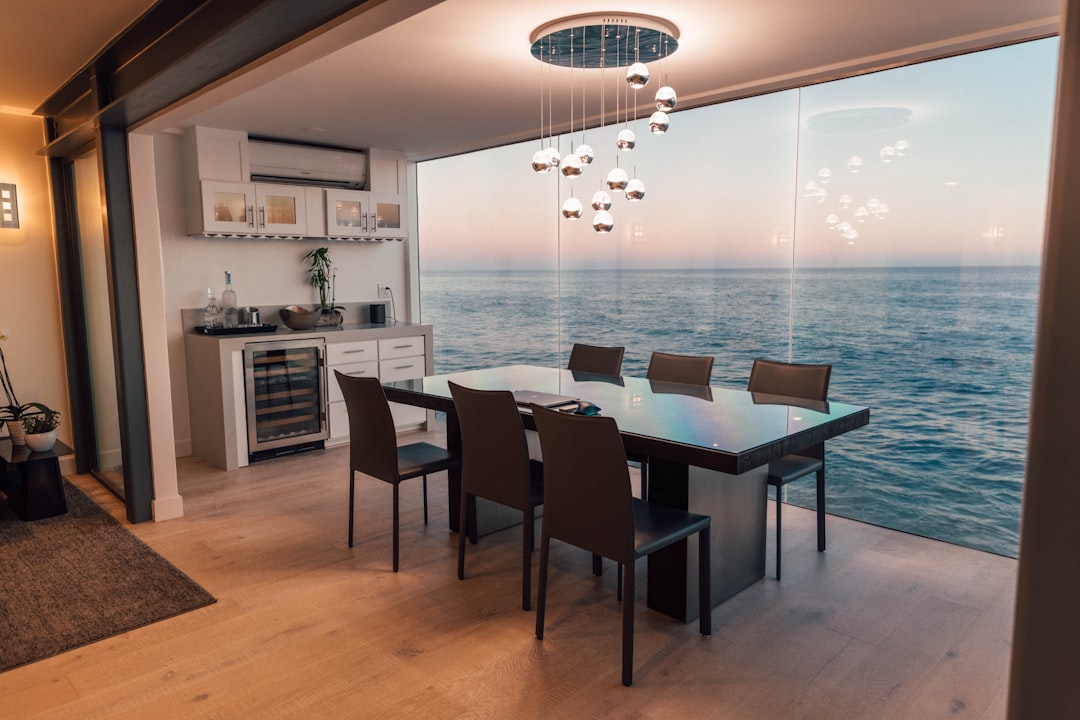The shift to remote work has changed how we work, including in interior design. More companies now offer virtual jobs. This means there’s a big need for designers who can work from anywhere.
We’re here to help you find remote opportunities in interior design. Our guide is for everyone, whether you’re experienced or new to the field. We’ll cover the benefits, skills, and tools you need to do well.
Key Takeaways
- Understanding the benefits of remote work in interior design
- Identifying the skills required to succeed in remote interior design jobs
- Exploring the tools and software necessary for remote interior design work
- Learning how to effectively search for remote interior design opportunities
- Tips for creating a strong portfolio for remote interior design jobs
Understanding Interior Design Remote Jobs
The move to remote work has brought new chances in interior design. It’s key for designers and clients to grasp the details of remote interior design. This work uses digital tools and platforms to manage projects from afar.
Definition of Remote Interior Design Work
Remote interior design covers many tasks. These include talking to clients, making design plans, picking materials, and overseeing projects. All these are done online. This flexibility in work arrangement lets designers work with clients anywhere, growing their reach.
Popular Roles in Remote Interior Design
There are several key roles in remote interior design. These include:
- Virtual Interior Designers: They work with clients to understand their design needs. They create custom design plans.
- Online Interior Decorators: They focus on the look of interior design. They help clients pick colors, furniture, and decor that match their style and budget.
- Remote Design Consultants: These experts give advice on design, space planning, and materials. They often work on a project-by-project basis.
These roles need creativity, technical skills, and good communication. Knowing these roles helps people find the right remote interior design job for them.
Benefits of Working Remotely in Interior Design
Working remotely in interior design has many benefits. It can improve your career and personal life. The flexibility, work-life balance, and access to clients worldwide are key advantages.
Flexibility in Schedule
Work from home interior design jobs offer great flexibility. Designers don’t need to commute, so they can manage their time better. This means they can work when they’re most productive.
Interior design experts say this flexibility boosts productivity and quality. It lets designers work at their best times.
“The flexibility to create your own schedule is a game-changer for many designers,”
they add.
Work-Life Balance
Having a good work-life balance is essential. Remote interior design helps achieve this. Designers can focus on their personal lives more easily.
Being at home makes it simpler to handle household tasks or family needs. This balance reduces stress and boosts job satisfaction. Designers find it helps their mental and physical health.
Access to a Global Client Base
Remote work lets designers reach clients worldwide. This is a big plus for remote interior decorator roles. It opens up new opportunities and experiences.
- Access to a broader client base
- Diverse project opportunities
- Enhanced professional growth through varied experiences
Remote work in interior design is beneficial for careers. It supports a sustainable and flexible work environment. As the industry grows, remote work will shape the future of interior design careers.
Key Skills Required for Interior Design Remote Jobs
To do well in remote interior design jobs, you need certain skills. These skills mix creativity, technical know-how, and soft skills. They are key for success in remote design consultant roles.
Creative and Technical Skills
Creative skills include knowing design basics, color theory, and how to arrange spaces. You also need to be good with design software like AutoCAD, SketchUp, and Adobe Creative Suite.
Technical skills help in making detailed designs and sharing ideas well. Knowing BIM software is also a plus.
Communication and Collaboration
Good communication is vital in remote work. Interior designers must share their ideas clearly and understand what clients want online.
Using collaboration tools and strategies is also important. Designers should know how to work together and communicate well.
Time Management and Organization
Managing your time well is key in remote work. Designers need to set priorities, manage their time, and meet deadlines.
Being organized is also crucial. This means keeping a tidy digital workspace and being able to find and share files easily.
| Skill Category | Specific Skills | Importance in Remote Jobs |
|---|---|---|
| Creative Skills | Understanding of design principles, color theory, spatial planning | High |
| Technical Skills | Proficiency in AutoCAD, SketchUp, Adobe Creative Suite, BIM software | High |
| Communication and Collaboration | Effective digital communication, collaboration tools, teamwork strategies | High |
| Time Management and Organization | Prioritizing tasks, time management, digital workspace organization | High |
Tools and Software for Interior Design Professionals
Interior designers working from home use special software and tools. These help them work better and talk easily with clients and team members.
Essential Design Software
Designers use different software to design and show off spaces. Some top picks are:
- AutoCAD for precise 2D and 3D drafting
- SketchUp for easy 3D modeling
- Adobe Creative Suite, like Photoshop and Illustrator, for detailed designs and presentations
These tools help designers make high-quality designs that clients love.
Project Management Tools
Good project management is key to finishing projects on time and within budget. Tools like:
- Asana for assigning and tracking tasks
- Trello for organizing projects into boards and cards
- Basecamp for full project management, including scheduling and teamwork
These tools keep designers organized and ensure projects run smoothly.
Communication Platforms
Good communication is essential for working well together from afar. Designers use:
- Zoom for video calls and meetings
- Skype for live chats and sharing screens
- Slack for team messages and sharing files
These platforms help designers stay in touch with clients and team members, no matter where they are.
By using these tools and software, interior designers can make their work better, work together better, and give top-notch results in the world of freelance interior design and virtual home styling.
Where to Find Interior Design Remote Job Listings
Finding remote interior design jobs is easier with the right tools. Today, designers have many platforms and tools to find work from home. This makes it simpler to find jobs that match their skills and goals.
Job Boards and Websites
Job boards and websites are top choices for remote interior design jobs. Sites like Upwork, Freelancer, and indeed offer a variety of remote jobs. Designers can create profiles, show their work, and apply for jobs that fit their skills.
| Job Board | Description | Fee Structure |
|---|---|---|
| Upwork | A platform connecting freelancers with businesses looking for various skills, including interior design. | Service fees range from 5% to 20% on top of the project rate. |
| Freelancer | A competitive platform where designers can bid on projects. | Fees include a project fee (3% or $3, whichever is greater) and optional upgrade fees. |
| indeed | A comprehensive job search engine that includes remote interior design listings. | Free for job seekers; employers pay for job postings. |
Social Media Platforms
Social media is also a great way to find remote interior design jobs. LinkedIn, Facebook, and Twitter are good places to start. Designers can join groups, follow companies, and talk to potential clients to find job openings.
Networking within Professional Communities
Networking can also help find remote jobs. Join online forums, go to virtual conferences, and attend local design events. This way, designers can meet other professionals and find job opportunities.
By using these resources, interior designers can find remote jobs that match their skills and goals.
Crafting an Impressive Interior Design Resume
When you’re looking for interior design remote jobs, a great resume is key. It’s your first chance to impress potential employers. Make sure to highlight your skills, experience, and achievements well.
To make a strong resume, know what works for online interior design positions. We’ll show you how to highlight your experience, showcase your portfolio, and tailor your resume for each job.
Highlighting Relevant Experience
Your experience is very important. For interior design remote jobs, focus on experiences that show you can work alone, manage projects from afar, and use digital tools well.
- List your past roles and what you did, focusing on tasks that fit remote interior design.
- Mention any freelance or project work that shows you can handle clients and deliver results from a distance.
- Use numbers to show how your work made a difference.
Showcasing Your Portfolio
A strong portfolio is a must for interior designers looking for online interior design positions. It shows off your skills and style, helping employers see what you can do for their projects.
To make your portfolio stand out:
- Share a link to your online portfolio or attach a PDF to your resume or application.
- Pick a variety of projects that show your range and flexibility as a designer.
- Explain each project, including your role, the challenges, and how you solved them.
Tailoring Your Resume for Specific Roles
Customizing your resume for each job is crucial, even more so for interior design remote jobs. Tailoring your resume to fit the job description can really help you stand out.
To tailor your resume well:
- Read the job description carefully, noting the key skills and qualifications needed.
- Adjust your resume to show how your skills, experience, and achievements match the job.
- Use the job posting’s language when describing your skills and qualifications.
By following these tips, you can make a resume that showcases your interior design skills and shows you’re great at remote work. This will make you a more appealing candidate for online interior design positions.
Acing the Remote Job Interview Process
The shift to remote work has changed how interior designers interview for jobs. It’s key to adapt and get ready for virtual interviews. Understanding the specifics of remote job interviews is crucial in the virtual interior design world.
Preparing for Common Interview Questions
To ace a remote job interview, prepare for common questions. Review your portfolio, know the job’s needs, and practice answers to interior design interview questions.
Key areas to focus on:
- Your experience with design software and technology
- Your approach to client communication and project management
- Your ability to work independently and manage time effectively
Demonstrating Remote Work Skills
Showing you can work well remotely is key. Show your skills with digital tools, your virtual collaboration skills, and how you stay organized and motivated.
Tips for demonstrating remote work skills:
- Highlight your experience with project management tools and software.
- Discuss your methods for maintaining clear and consistent communication with clients and team members.
- Share examples of successful remote projects you’ve managed or been a part of.
Following Up After the Interview
Following up after a remote job interview is crucial. It shows you’re still interested in the job and keeps you in the interviewer’s mind.
Best practices for follow-up:
- Send a thank-you note or email within 24 hours of the interview.
- Reiterate your interest in the position and highlight your relevant skills.
- Keep the message concise and professional.
By thoroughly preparing, showing your remote work skills, and following up professionally, you can boost your chances in remote interior decorator roles.
Continual Learning and Professional Development
The world of remote interior design is always changing. It’s key to keep learning. As we work in work from home interior design jobs and telecommute interior design positions, we must know the latest trends and skills.
Online Courses and Certifications
Online courses and certifications are great for improving our skills. Sites like Udemy, Coursera, and LinkedIn Learning have many courses. They cover everything from basic design to advanced software skills.
For example, we can learn about sustainable design. This is a big trend now.
Getting certifications, like the NCIDQ, can really help our careers. They show we’re serious about our work and follow industry rules.
Industry Trends and Resources
Knowing the latest trends is crucial for success in telecommute interior design positions. We can follow leaders and blogs like ArchDaily and Design Milk. They share the newest and upcoming trends.
Also, joining webinars and online forums is a good idea. They let us learn and meet others. We can share ideas and keep up with the best ways to work.
Joining Professional Associations
Being part of groups like the American Society of Interior Designers (ASID) has many benefits. These groups give us special resources. They include research, learning chances, and places to meet others.
Being in these groups also makes us look good professionally. It can lead to new chances to work together and grow our careers.
Overcoming Challenges in Remote Interior Design Work
Working remotely as an interior designer brings flexibility but also requires resilience and adaptability. It’s important to understand the challenges and how to overcome them in the world of remote design consultant jobs and freelance interior design gigs.

Managing Client Expectations
Remote interior designers face the challenge of managing client expectations. Clear communication is essential to ensure clients understand the design process, timelines, and what they can expect. Regular check-ins and project management tools help keep clients informed and involved.
To manage expectations well, it’s crucial to establish clear boundaries and be open about your work process. Be clear about your availability, response times, and how you prefer to communicate.
Staying Motivated and Productive
Staying motivated and productive while working remotely can be tough without a traditional office. Creating a dedicated workspace that boosts productivity and reduces distractions is key.
Setting clear goals and deadlines for yourself helps keep you on track. Establishing a routine with regular breaks and time for learning, like online courses or webinars, is also beneficial.
Addressing Isolation and Loneliness
Remote work can sometimes make you feel isolated and lonely. To combat this, stay connected with colleagues, peers, and friends through video calls or virtual coffee breaks.
Joining online communities or professional associations related to interior design can also help you feel connected. Being active in online forums or social media groups dedicated to interior design can reduce feelings of isolation.
Conclusion: Our Final Thoughts on Remote Interior Design Jobs
Remote interior design jobs are opening up many opportunities for professionals. With virtual home styling jobs, designers can work with clients worldwide. They use technology to make their creative ideas come to life.
Growing Demand
The need for remote interior design jobs is growing. This is because people want more flexibility and remote work is becoming more common. Interior designers can take advantage of this trend by improving their skills and meeting client needs.
Future Outlook
The future of remote interior design jobs looks promising. As technology gets better and the design world connects more, new chances will appear. Interior designers who stay updated and adapt can do well in this changing field.



